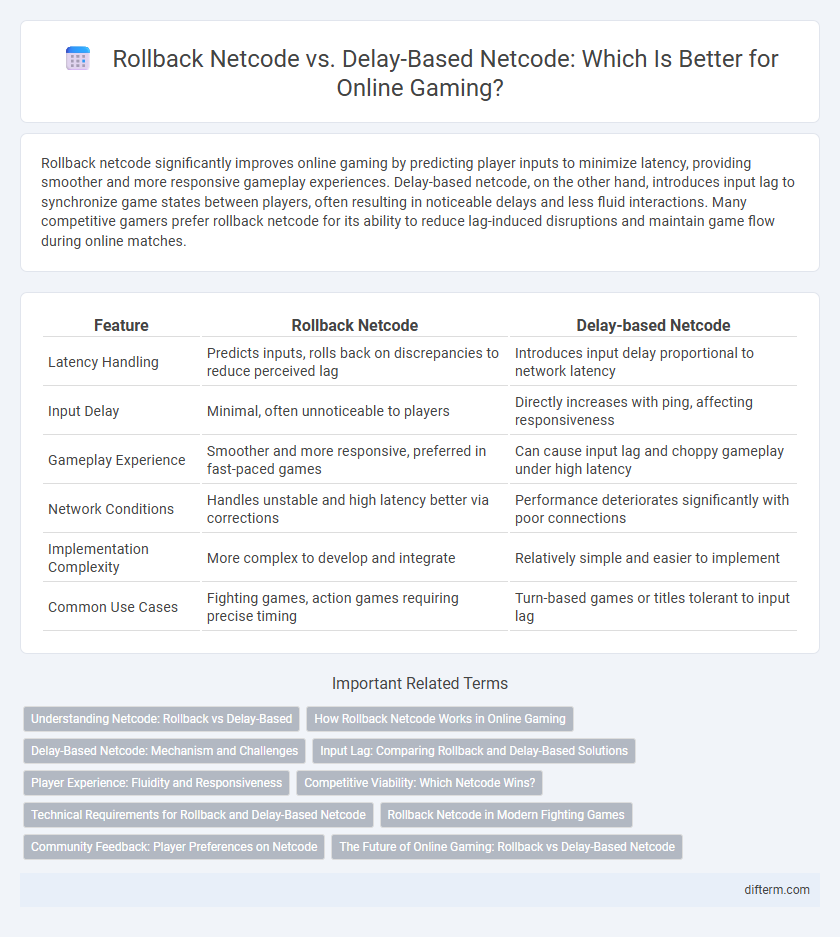Rollback netcode significantly improves online gaming by predicting player inputs to minimize latency, providing smoother and more responsive gameplay experiences. Delay-based netcode, on the other hand, introduces input lag to synchronize game states between players, often resulting in noticeable delays and less fluid interactions. Many competitive gamers prefer rollback netcode for its ability to reduce lag-induced disruptions and maintain game flow during online matches.
Table of Comparison
| Feature | Rollback Netcode | Delay-based Netcode |
|---|---|---|
| Latency Handling | Predicts inputs, rolls back on discrepancies to reduce perceived lag | Introduces input delay proportional to network latency |
| Input Delay | Minimal, often unnoticeable to players | Directly increases with ping, affecting responsiveness |
| Gameplay Experience | Smoother and more responsive, preferred in fast-paced games | Can cause input lag and choppy gameplay under high latency |
| Network Conditions | Handles unstable and high latency better via corrections | Performance deteriorates significantly with poor connections |
| Implementation Complexity | More complex to develop and integrate | Relatively simple and easier to implement |
| Common Use Cases | Fighting games, action games requiring precise timing | Turn-based games or titles tolerant to input lag |
Understanding Netcode: Rollback vs Delay-Based
Rollback netcode enhances online gaming by predicting player inputs and quickly correcting discrepancies, ensuring smoother and more responsive gameplay, especially in fast-paced fighting games. Delay-based netcode introduces input lag by waiting for all players' inputs before updating the game state, which can result in noticeable latency and disrupt timing-dependent mechanics. Understanding these fundamental differences helps competitive gamers choose platforms and games that offer the most fluid and fair online experiences.
How Rollback Netcode Works in Online Gaming
Rollback netcode in online gaming works by predicting player inputs and displaying immediate responses to minimize latency effects. When discrepancies occur between predicted and actual inputs, the game corrects the state by "rolling back" to a previous frame and re-simulating the game with the accurate data. This technique significantly reduces input delay and provides a smoother, more responsive experience compared to delay-based netcode, which waits for inputs before processing frames.
Delay-Based Netcode: Mechanism and Challenges
Delay-based netcode works by synchronizing game inputs through intentional input delay to compensate for latency, ensuring all players' actions are processed without desynchronization. This mechanism, while simplifying implementation, often results in noticeable input lag that can negatively impact fast-paced gameplay responsiveness. Challenges include maintaining a smooth player experience across varying connection qualities and preventing gameplay slowdowns during high latency or packet loss situations.
Input Lag: Comparing Rollback and Delay-Based Solutions
Rollback netcode significantly reduces input lag by predicting player inputs and correcting mispredictions in real-time, providing a seamless gameplay experience. Delay-based netcode increases input lag proportionally to network latency, causing noticeable delays between player actions and on-screen responses. Competitive gaming communities favor rollback netcode due to its minimal latency impact and smoother online interactions.
Player Experience: Fluidity and Responsiveness
Rollback netcode enhances player experience by predicting inputs and instantly correcting discrepancies, resulting in smoother, more fluid gameplay with minimal perceived lag. Delay-based netcode, by contrast, introduces input delay to synchronize players, which can cause sluggish responsiveness and hinder fast-paced actions in competitive gaming. Fluidity and responsiveness in rollback netcode make it the preferred choice for fighting games and fast reflex genres where timing precision is critical.
Competitive Viability: Which Netcode Wins?
Rollback netcode offers superior competitive viability by minimizing input lag and providing smoother gameplay, crucial for fast-paced fighting games where split-second reactions determine outcomes. Delay-based netcode introduces noticeable latency and input delay, compromising precision and player responsiveness in high-level matches. Pro players and tournament organizers overwhelmingly favor rollback netcode to ensure fair, skill-based competition with minimal network interference.
Technical Requirements for Rollback and Delay-Based Netcode
Rollback netcode requires precise input prediction algorithms and high-frequency state synchronization to minimize latency and maintain gameplay fluidity, relying heavily on client-side processing power and network stability. Delay-based netcode demands consistent low-latency connections and server-side input delay buffers to synchronize player actions, often sacrificing responsiveness for accuracy during network inconsistencies. Both systems necessitate robust network architectures but vary significantly in computational load distribution and tolerance to packet loss.
Rollback Netcode in Modern Fighting Games
Rollback netcode significantly improves online play in modern fighting games by predicting player inputs and instantly correcting discrepancies, reducing perceived lag. This technology is favored for its smooth and responsive gameplay, even under unstable internet conditions, enhancing competitive integrity. Titles like Street Fighter V and Guilty Gear Strive utilize rollback netcode to deliver near offline-quality matches, setting a new standard for fighting game online experiences.
Community Feedback: Player Preferences on Netcode
Community feedback highlights a strong preference for rollback netcode due to its smoother gameplay and reduced input delay, significantly enhancing competitive gaming experiences. Many players report frustration with delay-based netcode because it often results in noticeable lag and less responsive controls, especially in fast-paced fighting games. The active gaming communities on platforms like Discord and Reddit consistently advocate for rollback netcode implementation to ensure fair and enjoyable online matches.
The Future of Online Gaming: Rollback vs Delay-Based Netcode
Rollback netcode offers superior responsiveness by predicting player actions and correcting discrepancies, significantly reducing input lag compared to delay-based netcode, which waits for opponent data before executing moves. As the gaming industry advances towards more competitive and latency-sensitive environments, rollback netcode becomes essential for delivering smooth, real-time multiplayer experiences even over unstable internet connections. Future online gaming infrastructures are increasingly adopting rollback netcode due to its ability to minimize perceived lag and enhance player satisfaction in fast-paced genres like fighting games and first-person shooters.
Rollback Netcode vs Delay-based Netcode Infographic

 difterm.com
difterm.com